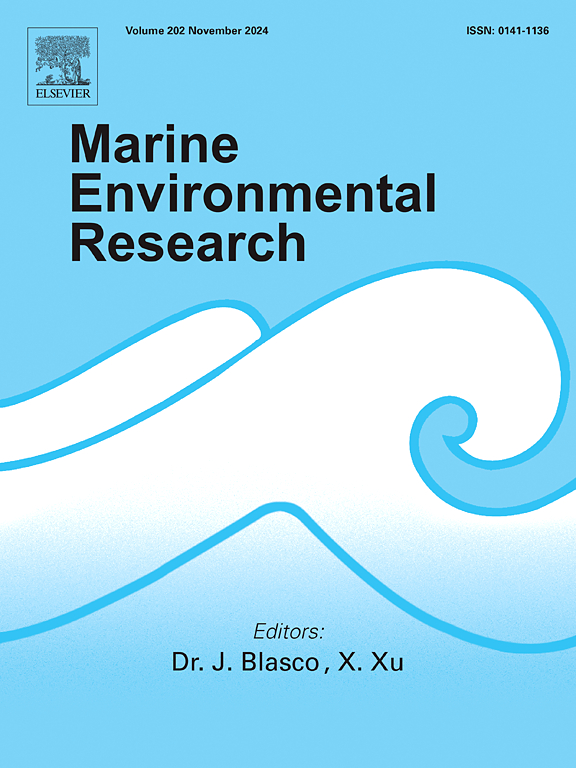Impact of Alaska atmospheric blocking on the carbon flux in the Northeast Pacific Ocean
IF 3
3区 环境科学与生态学
Q2 ENVIRONMENTAL SCIENCES
引用次数: 0
Abstract
The Northeast Pacific Ocean (NEP) is one of the important carbon sinks in the global ocean. The causes of carbon flux changes in this region have been widely studied, but the physical processes associated with large scale climate variability remain controversial primarily due to scarcity of spatially and temporally continuous observations. In this study, we constructed a high-resolution sea surface partial pressure of CO2 (pCO2) from satellite observations for the NEP from 2003 to 2020 using the machine learning based XGBoost model. By analyzing the interannual large-scale high-latitude atmospheric dynamics and ocean physical conditions over the NEP, we find that the CO2 flux density (FCO2) anomalies have a strong correlation with the Alaskan atmospheric blocking events. In the region north of 48°N, anomalous cyclones triggered by atmospheric blocking increased sea surface height (SSH), which reduced the replenishment of dissolved inorganic carbon (DIC) from deep seawater, leading to enhanced carbon uptake. By contrast, in the region south of 48°N, the increase in sea surface temperature (SST) triggered by atmospheric blocking reduced the solubility of CO2 in seawater, resulting in a decrease in regional carbon flux. These results provide new perspectives for better understanding and predicting the effects of high-latitude atmospheric dynamics on regional ocean carbon fluxes.
阿拉斯加大气阻塞对东北太平洋碳通量的影响。
东北太平洋(NEP)是全球海洋中重要的碳汇之一。该区域碳通量变化的原因已被广泛研究,但与大尺度气候变异相关的物理过程仍存在争议,主要原因是缺乏时空连续观测数据。在本研究中,我们利用基于机器学习的 XGBoost 模型,从卫星观测数据中构建了 2003-2020 年国家环保局的高分辨率海面二氧化碳分压(pCO2)。通过分析 NEP 上的年际大尺度高纬度大气动力学和海洋物理条件,我们发现二氧化碳通量密度(FCO2)异常与阿拉斯加大气阻塞事件有很强的相关性。在北纬 48 度以北地区,大气阻塞引发的异常气旋增加了海面高度(SSH),从而减少了深层海水对溶解无机碳(DIC)的补充,导致碳吸收增加。相比之下,在北纬 48 度以南地区,大气阻塞引发的海面温度(SST)升高降低了二氧化碳在海水中的溶解度,导致区域碳通量减少。这些结果为更好地理解和预测高纬度大气动力学对区域海洋碳通量的影响提供了新的视角。
本文章由计算机程序翻译,如有差异,请以英文原文为准。
求助全文
约1分钟内获得全文
求助全文
来源期刊

Marine environmental research
环境科学-毒理学
CiteScore
5.90
自引率
3.00%
发文量
217
审稿时长
46 days
期刊介绍:
Marine Environmental Research publishes original research papers on chemical, physical, and biological interactions in the oceans and coastal waters. The journal serves as a forum for new information on biology, chemistry, and toxicology and syntheses that advance understanding of marine environmental processes.
Submission of multidisciplinary studies is encouraged. Studies that utilize experimental approaches to clarify the roles of anthropogenic and natural causes of changes in marine ecosystems are especially welcome, as are those studies that represent new developments of a theoretical or conceptual aspect of marine science. All papers published in this journal are reviewed by qualified peers prior to acceptance and publication. Examples of topics considered to be appropriate for the journal include, but are not limited to, the following:
– The extent, persistence, and consequences of change and the recovery from such change in natural marine systems
– The biochemical, physiological, and ecological consequences of contaminants to marine organisms and ecosystems
– The biogeochemistry of naturally occurring and anthropogenic substances
– Models that describe and predict the above processes
– Monitoring studies, to the extent that their results provide new information on functional processes
– Methodological papers describing improved quantitative techniques for the marine sciences.
 求助内容:
求助内容: 应助结果提醒方式:
应助结果提醒方式:


